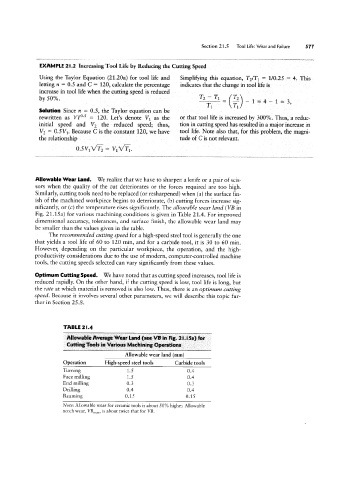Page 596 - 04. Subyek Engineering Materials - Manufacturing, Engineering and Technology SI 6th Edition - Serope Kalpakjian, Stephen Schmid (2009)
P. 596
Section 21.5 Tool Life: Wear and Failure 577
EXAMPLE 2 L2 Increasing Tool Life by Reducing the Cutting Speed
Using the Taylor Equation (21.20a) for tool life and Simplifying this equation, T2/T1 = 1/0.25 == 4. This
letting n = 0.5 and C = 120, calculate the percentage indicates that the change in tool life is
increase in tool life when the cutting speed is reduced
by 50%. T2”T1-(T;> _
__
T1 _ T] 1~4 1-3,
Solution Since n = 0.5, the Taylor equation can be
rewritten as VT°‘5 = 120. Let’s denote V1 as the or that tool life is increased by 300%. Thus, a reduc-
initial speed and V2 the reduced speed; thus, tion in cutting speed has resulted in a major increase in
VZ = 0.5 Vi. Because C is the constant 120, we have tool life. Note also that, for this problem, the magni~
the relationship tude of C is not relevant.
0.5v,\/ir; = V1\/Tl.
Allowable Wear Land. We realize that we have to sharpen a knife or a pair of scis-
sors when the quality of the cut deteriorates or the forces required are too high.
Similarly, cutting tools need to be replaced (or resharpened) when (a) the surface fin-
ish of the machined workpiece begins to deteriorate, (b) cutting forces increase sig-
nificantly, or (c) the temperature rises significantly. The allowable u/ear land (VB in
Fig. 21.15 a) for various machining conditions is given in Table 21.4. For improved
dimensional accuracy, tolerances, and surface finish, the allowable wear land may
be smaller than the values given in the table.
The recommended cutting speed for a high-speed steel tool is generally the one
that yields a tool life of 60 to 120 min, and for a carbide tool, it is 30 to 60 min.
However, depending on the particular workpiece, the operation, and the high-
productivity considerations due to the use of modern, computer-controlled machine
tools, the cutting speeds selected can vary significantly from these values.
Optimum Cutting Speed. We have noted that as cutting speed increases, tool life is
reduced rapidly. On the other hand, if the cutting speed is low, tool life is long, but
the rate at which material is removed is also low. Thus, there is an optimum cutting
speed. Because it involves several other parameters, we will describe this topic fur-
ther in Section 25.8.
TABLE 2 |.4
Allowable Average Wear Land (see VB in Fig. 2I.l5a) for
Cutting Tools in Various Machining Operations
Allowable wear land (mm)
Operation High-speed steel tools Carbide tools
Turning 1.5 0.4
Face milling 1.5 0.4
End milling 0.3 0.3
Drilling 0.4 0.4
Reaming 0.15 0.15
Note: Allowable wear for ceramic tools is about 50% higher. Allowable
notch Wear, VBWX, is about twice that for VB.

